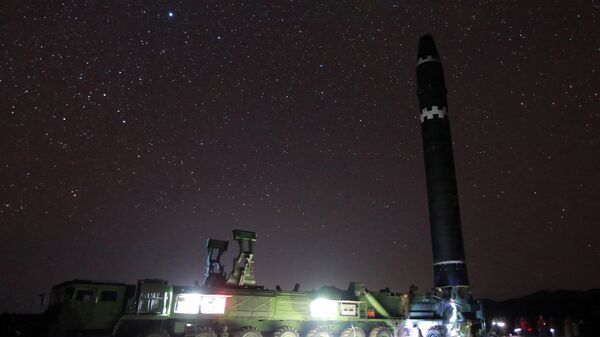North Korea's Hwasong-15 intercontinental ballistic missile is capable of hitting anywhere inside the continental United States in the event of war, US Forces Korea has confirmed in its 2019 Strategic Digest command publication.
The missile, test-fired by the North Korean military in November 2017, is said to have an estimated striking range of 12,875 km (8,000 miles), giving it the theoretical ability to strike the US from coast to coast. An unnamed military source told Chosun Ilbo that the US Forces Korea estimate was based on a "comprehensive analysis of intelligence data collected from satellite, aircraft and radar surveillance" of North Korea's recent missile testing efforts.
The report confirms earlier claims by North Korean media about the Hwasong-15's capabilities and range. Following the November 2017 test launch, the Korean Central News Agency reported that the missile could strike "the whole of the mainland of the US," and could be "tipped with [a] super-large heavy warhead" of an undisclosed weight.
During the 2017 launch, the missile was said to have reached an altitude of 4,475 km and flown a linear distance equal to 950 km before coming down inside the sea area of Japan's exclusive economic zone.
US and South Korean intelligence have yet to confirm whether the Hwasong-15 can be fitted with a nuclear payload, although it is assumed to be capable of carrying a warhead weighing up to 1,000 kg, and possibly equipped with the ability to carry multiple warheads simultaneously.
The Hwasong-14, another North Korean ICBM tested in mid-2017, was also mentioned in the report, and said to be capable of reaching "most" of the US mainland, given its 10,000km+ (6250 mile) range.
The personal friendly rapport between President Donald Trump and Chairman Kim Jong-un, exemplified late last month after Trump became the first US president to set foot inside North Korea, has been contrasted by continuing tensions between the countries over US sanctions policy against Pyongyang. Last week, the North Korean mission to the UN accused Washington of being "obsessed with sanctions and a pressure campaign" and "more and more hell-bent on hostile acts" against Pyongyang despite peace efforts.
Kim and Trump's June 30 talks were their third to date, and followed a landmark meeting in Singapore in in June 2018 during which the two leaders expressed commitment to denuclearization and de-escalation on the Korean peninsula, as well as the less successful talks in Vietnam in February 2019, which ended abruptly with no apparent agreement. Following the latest meeting, Trump said sanctions against Korea would remain in place, but added that the issue would be discussed in future talks between the two sides over the coming months.
On Thursday, North Korea slammed South Korea over Seoul's purchase of Lockheed Martin's F-35 fighters, and vowed to develop and test unspecified "special armaments" capable of destroying the stealth planes if South Korea continued to deploy them. South Korea has a total of 40 of the US-made planes on order, with up to ten expected to be delivered before the end of the year.



